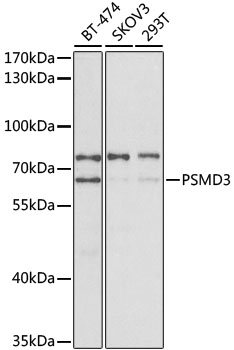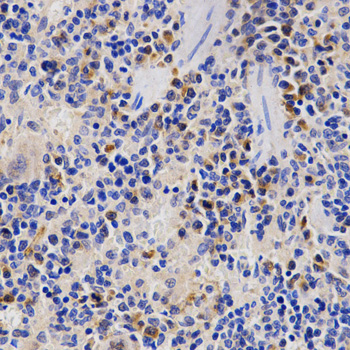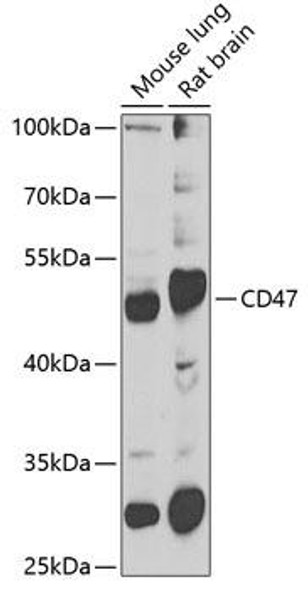Cell Biology Antibodies 8
Anti-PSMD3 Antibody (CAB2790)
- SKU:
- CAB2790
- Product Type:
- Antibody
- Reactivity:
- Human
- Reactivity:
- Mouse
- Reactivity:
- Rat
- Host Species:
- Rabbit
- Isotype:
- IgG
- Research Area:
- Cell Biology
Description
| Antibody Name: | Anti-PSMD3 Antibody |
| Antibody SKU: | CAB2790 |
| Antibody Size: | 20uL, 50uL, 100uL |
| Application: | WB IHC |
| Reactivity: | Human, Mouse, Rat |
| Host Species: | Rabbit |
| Immunogen: | A synthetic peptide of human PSMD3 |
| Application: | WB IHC |
| Recommended Dilution: | WB 1:500 - 1:2000 IHC 1:50 - 1:200 |
| Reactivity: | Human, Mouse, Rat |
| Positive Samples: | BT-474, SKOV3, 293T |
| Immunogen: | A synthetic peptide of human PSMD3 |
| Purification Method: | Affinity purification |
| Storage Buffer: | Store at -20'C. Avoid freeze / thaw cycles. Buffer: PBS with 0.02% sodium azide, 50% glycerol, pH7.3. |
| Isotype: | IgG |
| Sequence: | Email for sequence |
| Gene ID: | 5709 |
| Uniprot: | O43242 |
| Cellular Location: | |
| Calculated MW: | 41kDa/60kDa |
| Observed MW: | 65kDa |
| Synonyms: | PSMD3, P58, RPN3, S3, TSTA2 |
| Background: | The 26S proteasome is a multicatalytic proteinase complex with a highly ordered structure composed of 2 complexes, a 20S core and a 19S regulator. The 20S core is composed of 4 rings of 28 non-identical subunits; 2 rings are composed of 7 alpha subunits and 2 rings are composed of 7 beta subunits. The 19S regulator is composed of a base, which contains 6 ATPase subunits and 2 non-ATPase subunits, and a lid, which contains up to 10 non-ATPase subunits. Proteasomes are distributed throughout eukaryotic cells at a high concentration and cleave peptides in an ATP/ubiquitin-dependent process in a non-lysosomal pathway. This gene encodes a member of the proteasome subunit S3 family that functions as one of the non-ATPase subunits of the 19S regulator lid. Single nucleotide polymorphisms in this gene are associated with neutrophil count. |
| UniProt Protein Function: | PSMD3: Acts as a regulatory subunit of the 26 proteasome which is involved in the ATP-dependent degradation of ubiquitinated proteins. Belongs to the proteasome subunit S3 family. |
| UniProt Protein Details: | Protein type:Protease; Proteasome complex Chromosomal Location of Human Ortholog: 17q21.1 Cellular Component: proteasome complex; nucleoplasm; membrane; cytoplasm; nucleus; cytosol Molecular Function:enzyme regulator activity Biological Process: ubiquitin-dependent protein catabolic process; positive regulation of ubiquitin-protein ligase activity during mitotic cell cycle; negative regulation of ubiquitin-protein ligase activity during mitotic cell cycle; protein polyubiquitination; viral reproduction; apoptosis; antigen processing and presentation of exogenous peptide antigen via MHC class I, TAP-dependent; DNA damage response, signal transduction by p53 class mediator resulting in cell cycle arrest; regulation of apoptosis; antigen processing and presentation of peptide antigen via MHC class I; regulation of ubiquitin-protein ligase activity during mitotic cell cycle; anaphase-promoting complex-dependent proteasomal ubiquitin-dependent protein catabolic process; antigen processing and presentation of exogenous peptide antigen via MHC class I; gene expression; mitotic cell cycle; regulation of amino acid metabolic process; G1/S transition of mitotic cell cycle; negative regulation of apoptosis |
| NCBI Summary: | The 26S proteasome is a multicatalytic proteinase complex with a highly ordered structure composed of 2 complexes, a 20S core and a 19S regulator. The 20S core is composed of 4 rings of 28 non-identical subunits; 2 rings are composed of 7 alpha subunits and 2 rings are composed of 7 beta subunits. The 19S regulator is composed of a base, which contains 6 ATPase subunits and 2 non-ATPase subunits, and a lid, which contains up to 10 non-ATPase subunits. Proteasomes are distributed throughout eukaryotic cells at a high concentration and cleave peptides in an ATP/ubiquitin-dependent process in a non-lysosomal pathway. This gene encodes a member of the proteasome subunit S3 family that functions as one of the non-ATPase subunits of the 19S regulator lid. Single nucleotide polymorphisms in this gene are associated with neutrophil count. [provided by RefSeq, Jul 2012] |
| UniProt Code: | O43242 |
| NCBI GenInfo Identifier: | 20532405 |
| NCBI Gene ID: | 5709 |
| NCBI Accession: | O43242.2 |
| UniProt Secondary Accession: | O43242,Q96EI2, Q9BQA4, B3KMW9, B4DT72, |
| UniProt Related Accession: | O43242 |
| Molecular Weight: | 534 |
| NCBI Full Name: | 26S proteasome non-ATPase regulatory subunit 3 |
| NCBI Synonym Full Names: | proteasome (prosome, macropain) 26S subunit, non-ATPase, 3 |
| NCBI Official Symbol: | PSMD3 |
| NCBI Official Synonym Symbols: | S3; P58; RPN3; TSTA2 |
| NCBI Protein Information: | 26S proteasome non-ATPase regulatory subunit 3; proteasome subunit p58; 26S proteasome regulatory subunit S3; 26S proteasome regulatory subunit RPN3; tissue specific transplantation antigen 2 |
| UniProt Protein Name: | 26S proteasome non-ATPase regulatory subunit 3 |
| UniProt Synonym Protein Names: | 26S proteasome regulatory subunit RPN3; 26S proteasome regulatory subunit S3; Proteasome subunit p58 |
| Protein Family: | 26S proteasome non-ATPase regulatory |
| UniProt Gene Name: | PSMD3 |
| UniProt Entry Name: | PSMD3_HUMAN |








